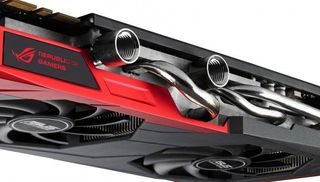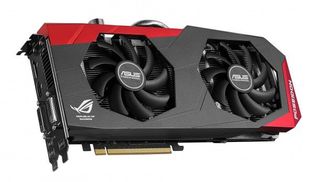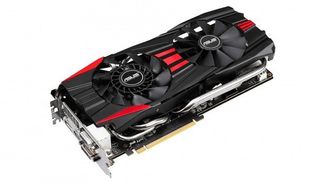Asus announces Poseidon GTX 780, with hybrid air and water cooling

Asus are planning to expand their Republic of Gamers line-up with two new high-end Nvidia cards - The Poseidon GTX 780 and the GTX 780 Ti DirectCU II. The Poseidon will add a hybrid cooling solution to the GK 110 GPU at the core of the standard GTX 780 .
The DirectCU H2O cooling array can work as either a standard active air cooler or a full-blown liquid chilling water block. There's a custom-designed vapour chamber in contact with the GPU, with a bunch of fat copper pipes pulling the heat from the core. On its own that air-cooling portion of the setup can keep the GTX 780 some 7ºC cooler than the reference chiller.

The idea of the Poseidon is to give you the option to plumb the card into a proper water-cooling system. The standard fittings on the water block are designed so that they can fit most standard setups allowing you to just plug and play. Well, once you've drained the system and checked for leaks, anyway.
With this water cooling Asus reckons you'll be able to get some 24ºC cooler than the reference design. By my reckoning that would have it running around 56ºC with a fully loaded GPU. That's mighty cool.
But it's not the top-tier Nvidia card that's getting this treatment - though arguably sticking it on the molten R9 290X would be a better shout - Asus are going with the standard DirectCU II active air cooler for its overclocked GTX 780 Ti .

That's the top GK110 card, rocking the full compliment of fifteen SMX modules and 2,880 CUDA cores. The GPU is factory-overclocked out of the box. Running at 1,020MHz, it's a good deal quicker than the reference design. My reference design card runs at 1,019MHz as standard once with GPU Boost 2.0 active. The Asus version then should go pretty significantly past that right from the off.
But obviously neither of these cards are going to be cheap. The Poseidon GTX 780 is going to be retailing for around £500 and the GTX 780 Ti DirectCU II is likely to be around £620.
PC Gamer Newsletter
Sign up to get the best content of the week, and great gaming deals, as picked by the editors.

Dave has been gaming since the days of Zaxxon and Lady Bug on the Colecovision, and code books for the Commodore Vic 20 (Death Race 2000!). He built his first gaming PC at the tender age of 16, and finally finished bug-fixing the Cyrix-based system around a year later. When he dropped it out of the window. He first started writing for Official PlayStation Magazine and Xbox World many decades ago, then moved onto PC Format full-time, then PC Gamer, TechRadar, and T3 among others. Now he's back, writing about the nightmarish graphics card market, CPUs with more cores than sense, gaming laptops hotter than the sun, and SSDs more capacious than a Cybertruck.
Most Popular




